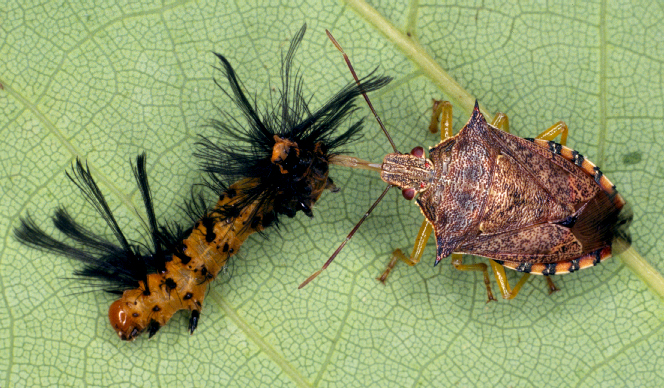
My reaction to a stinkbug on one of my plants is to squash it as quickly as possible – I have no qualms about handpicking pests – even stinkbugs! However, in the same neighborhood as the “bad” stinkbug, there are “good” stinkbugs. That is good in the sense of their habit of eating bad insects. This good stinkbug is known as the spined soldier bug, and it looks similar, but distinctly different, than other common stinkbugs.
First, let’s use the southern green stinkbug as an example of a bad stinkbug. This green stinkbug is shaped like a small shield with a rounded thorax. This insect feeds on a number of plants using a long, straw-like piercing/sucking mouthpart to suck fluids from plant parts. Plant parts punctured by the green stinkbug will be blemished or withered in appearance.
Enter our hero – the spined soldier! The spined soldier bug starts its life out as a small dark egg, one of up to seventy in a loose oval cluster looking like tiny, ornate buttons. As a baby bug, this soldier develops from a basic black and red color into a colorful nymph of orange, white, black and red as it molts and develops though different stages. Sometimes becoming cannibalistic, the nymph stages of this bug resemble the adult, but without the wings. One common Florida species, Podisus maculiventris or spined soldier bug , is mottled brown as an adult. Regardless of the color, one distinguishing mark are the spines on the thorax or shoulders of the adults. Most stinkbugs, like the southern green stinkbug, mentioned above, have rounded shoulders. Another difference is that the spined soldier has a short sharp beak; regular stinkbugs have long thin mouthparts.
So what’s so good about the spined soldier? They are predacious and love to eat caterpillars and beetle larvae – ninety species are on the menu! With their sharp, stout mouthparts set straight ahead, the bug impales its victim and sucks out the body juices, killing the pest. Local pests controlled include, but are not limited to, European corn borers, corn earworms, oleander caterpillars, fall armyworms, and flea beetle larvae. These are good friends to have around in your garden!
What is the moral of this story? Even bad bugs have good bug relatives waiting in the wings. Appearances can be deceiving – what may be a beneficial insect could be confused with a pest and accidentally destroyed. Before you break out the pesticide, have the creature identified – the first step in any good Integrated Pest Management program. Having beneficial insects around will help keep pests in balance! For more information on all types of beneficial insects, or to ask a question, please visit https://www.facebook.com/CharlotteMGLifeline/. Ralph E. Mitchell is the Director/Horticulture Agent for the UF/IFAS Charlotte County Extension Service. He can be reached at 941-764-4344 or ralph.mitchell@charlottecountyfl.gov.
Resources:
Richman, D. B., Mead, F. W. & Fasulo, T. R. (2017) Spined Soldier Bug, Podisus maculiventris (Say) (Insecta: Hemiptera: Pentatomidae). University of Florida Extension Service/IFAS.
Squitier, J. M. (2017) Southern Green Stink Bug, Nezara viridula (Linnaeus) (Insecta: Hemiptera: Pentatomidae). University of Florida Extension Service/IFAS.
McAuslane, H. ( 2020) Oleander caterpillar. Featured Creatures – University of Florida Extension Service, IFAS.
 0
0
